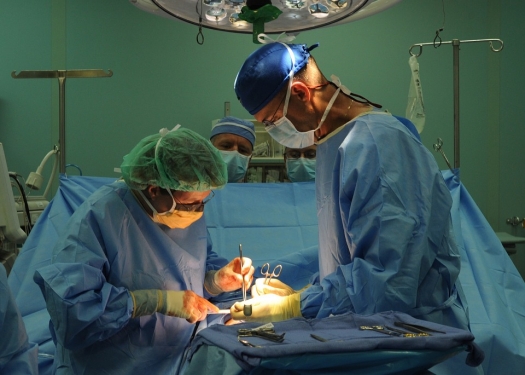When Sharon checked into the hospital, her most pressing concern was how soon she’d be back on her feet. She was so busy with her church, volunteer work in her retirement community, and family and social activities that she just didn’t have time to be laid up.
Surgery went well, but afterward she was confused and disoriented. Sharon and her family were assured this was a temporary side effect of surgery and she would soon return to her old self. She never did. A year later she still had trouble remembering names, forgot meetings, accidentally skipped meals, and often got lost. When the highway patrol pulled her over for driving her golf cart on the freeway, her sons knew it was time for mom to move to assisted living.
Let’s look at the dangers of inappropriate and unnecessary surgeries.
Overhyped, underperforming
For trauma care, acute stroke, a ruptured appendix, and other medical emergencies, there’s no better place to be than in a good American hospital under the care of a top-notch surgical team. Unfortunately, a disturbing number of elective surgeries are not the indispensable, lifesaving interventions they’re cracked up to be.
Research reveals that a host of invasive procedures are all too often performed on patients who stand to gain no real benefit – but are unavoidably exposed to the potential harms of hospitalization and surgery. Procedures that fall into this category include gastric bypass, heartburn surgery, implanted defibrillators, pacemakers, radical prostatectomy, double mastectomy, thyroidectomy, and Mohs surgery for skin cancer. But the following are the most often overused:
Heart Procedures
Solid scientific research dating back to the 1970s makes it clear that most patients who undergo coronary artery bypass surgery, angioplasty, and coronary artery stenting are no less likely to have a heart attack or die than those treated with medications. The majority of the 1.5 million people who have these procedures yearly have stable angina – or no symptoms at all – and do just fine with medications, supplements, exercise, diet changes, EECP (a natural “bypass”), and other noninvasive therapies.
Back Surgery
Multiple studies show that people with low back pain have similar outcomes with or without surgery, making the bulk of the 600,000 spinal fusions, laminectomies, etc., superfluous at best. A recent study found physical therapy to be as effective as surgery for painful spinal stenosis, and many Whitaker Wellness patients report long-term relief with prolotherapy and platelet-rich plasma. Flare-ups can also be curbed with curcumin and other natural anti-inflammatories, topical painkillers and DMSO, chiropractic, acupuncture, and high-intensity laser treatment.
Knee Surgery
Arthroscopic surgery of the knee, which is performed 700,000 times per year, may be minimally invasive, but it’s also minimally effective. Studies conducted in the US, Canada, and Finland found that sham surgery worked just as well! Joint replacement surgery is also under increasing scrutiny, as a 2014 study concluded that one-third of knee replacements may be inappropriate and unnecessary.
Hysterectomy
One in three American women will undergo hysterectomy by age 60, usually for benign conditions such as bleeding, fibroids, or endometriosis. These problems can often be treated conservatively, but a 2013 study revealed that nearly 40 percent of women were never offered other treatments prior to surgery. Cesarean sections are also overused and now account for 32 percent of all US births – two to three times the 10–15 percent rate experts consider medically necessary.
What can go wrong?
The Institute of Medicine estimates that our country loses $750 billion per year to fraud, inefficiencies, inflated prices and administrative costs, and other healthcare-related waste. But the biggest chunk of change goes toward unnecessary services, including inappropriate surgeries. Anyone who’s had sticker shock from hospital bills knows surgery impacts personal finances as well. Medical bills are America’s leading cause of bankruptcies!
Money’s not the half of it. Hospitals and surgeries are risky business, and you could end up like Sharon, with more problems than you started with.
You could react poorly to anesthesia and medications or get the wrong drugs, doses, or combinations. You could end up with a bedsore (pressure ulcer), as 2.5 million patients do annually during prolonged hospital stays (and 60,000 die as a result).
You could develop blood clots. Risk of deep vein thrombosis and pulmonary embolism increases after surgery, especially orthopedic procedures. You could have postoperative cognitive dysfunction, which is particularly common after cardiac surgery. It usually resolves within days to weeks but, as in Sharon’s case, is sometimes permanent.
You could come down with a hospital-acquired infection, which affect 1 in 25 patients on any given day and cause 75,000 deaths per year. Surgical site and catheter-related urinary tract infections are very common, and one in seven involve virulent antibiotic-resistant bacteria.
You could also be the victim of carelessness, incompetence, and human error. Most of the medical mistakes that kill 251,000 Americans annually occur in hospitals.
Doing nothing
I’m not trying to scare you or suggest you forego all hospitalizations and procedures. Some are absolutely necessary. However, it’s imperative to think and act critically when making decisions about surgery.
Dartmouth Medical School professor H. Gilbert Welch, MD, writes in his excellent new book Less Medicine, More Health: “When there is a problem, there is pressure to do something: Prescribe a medicine. Order a test. Refer to a specialist. Admit to the hospital. Perform an operation. The pressure to do something reflects from a belief that action is preferable to inaction. But the reality is that the human body can heal and that all of our actions have unintended consequences. Thus, inaction can often be the preferred course.”
If you’re recommended to have surgery, the most important question you can ask might be: “What happens if I do nothing?”
References
Makary MA, et al. Medical error – the third leading cause of death in the US. BMJ. 2016 May; 353:i2139.
Welch HG. Less Medicine, More Health: 7 Assumptions That Drive Too Much Medical Care. 2016. Beacon Press, Boston, MA.
Inpatient surgery. National Center for Health Statistics.
Reprinted from Dr. Julian Whitaker’s Health & Healing newsletter, ©Healthy Directions, LLC. Used with permission.



